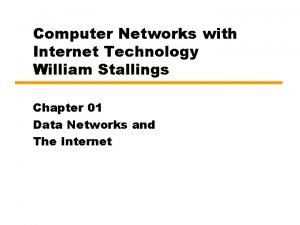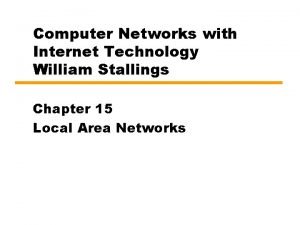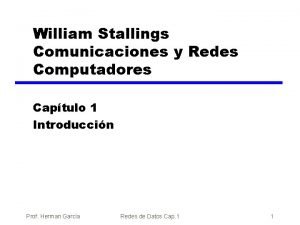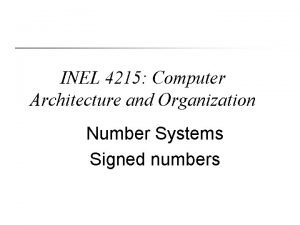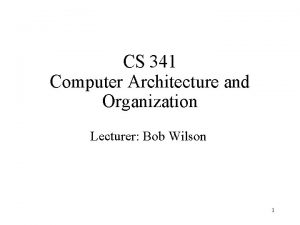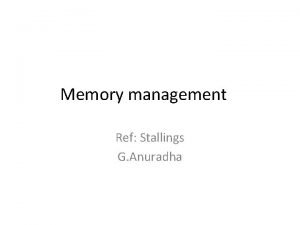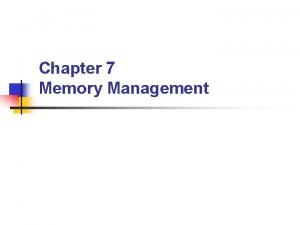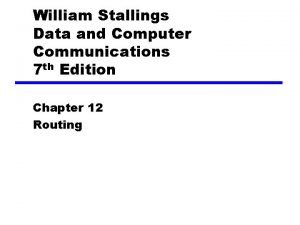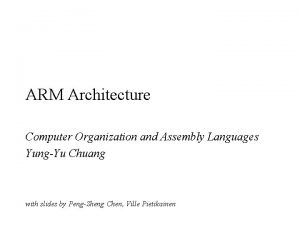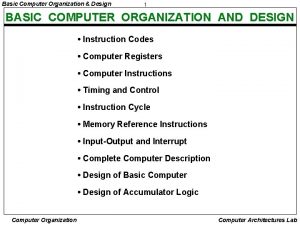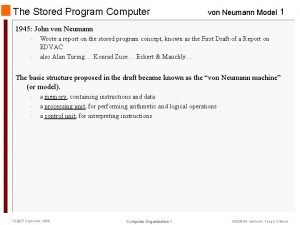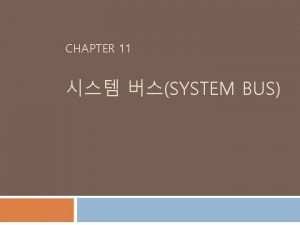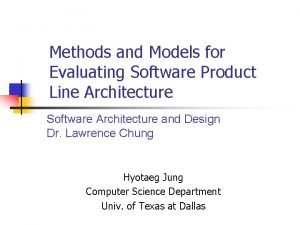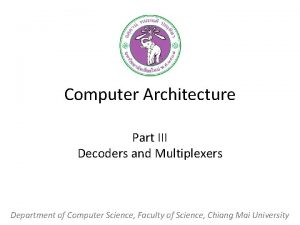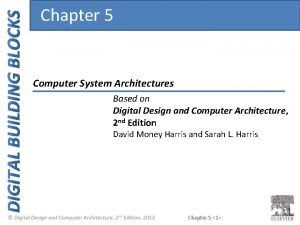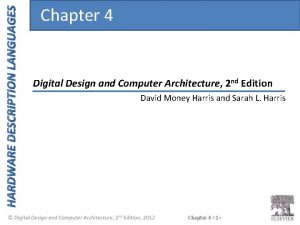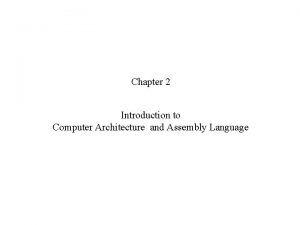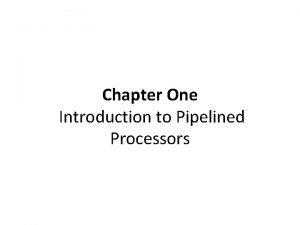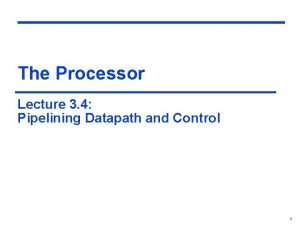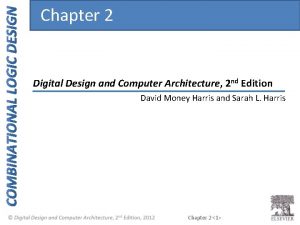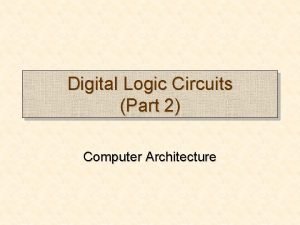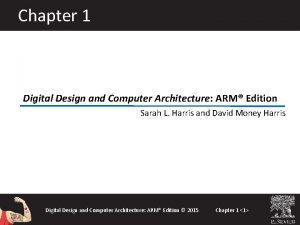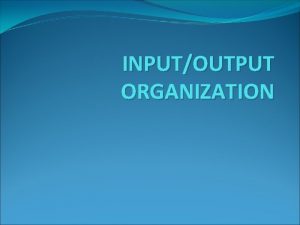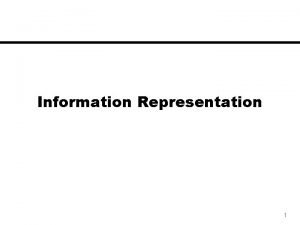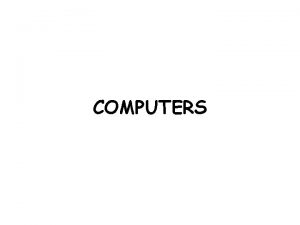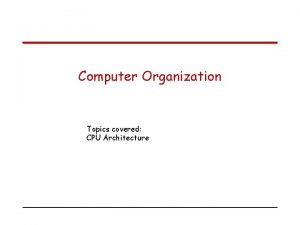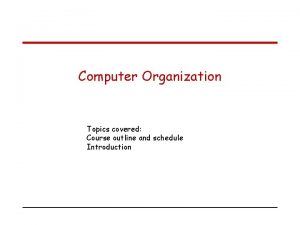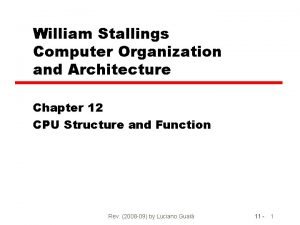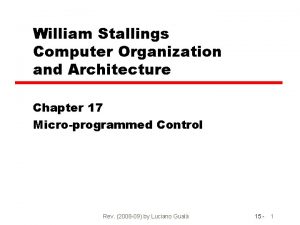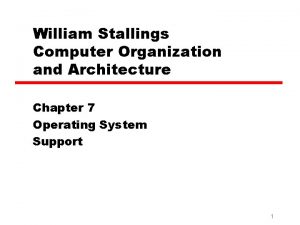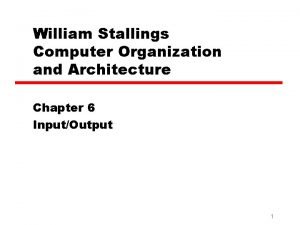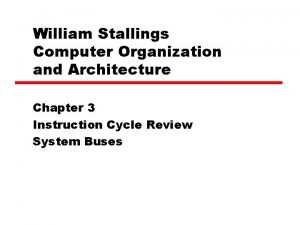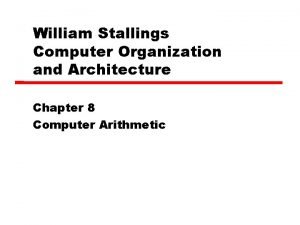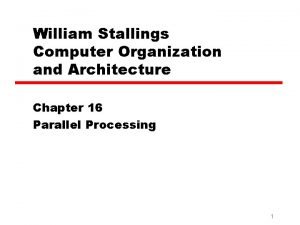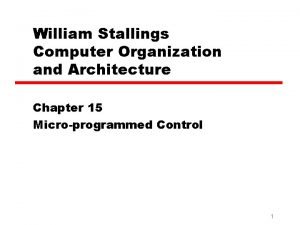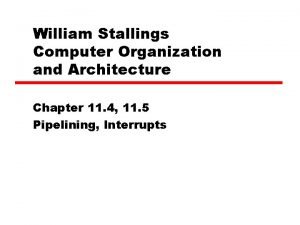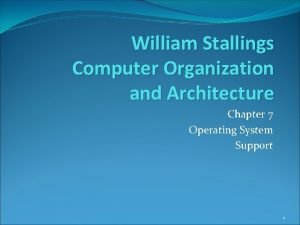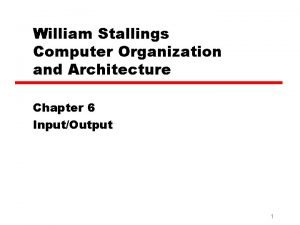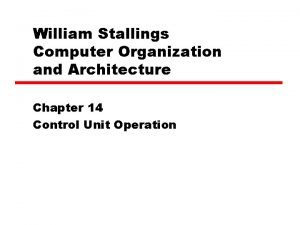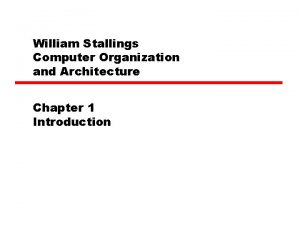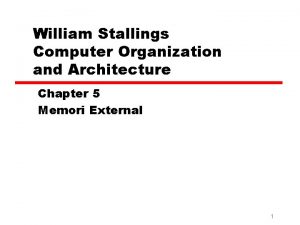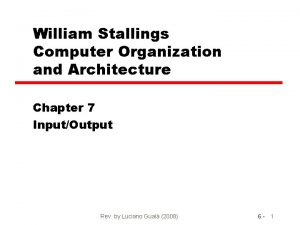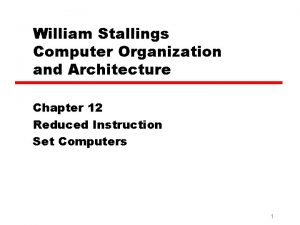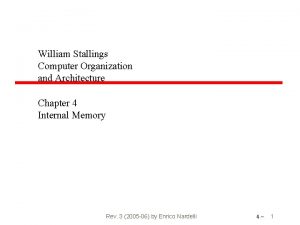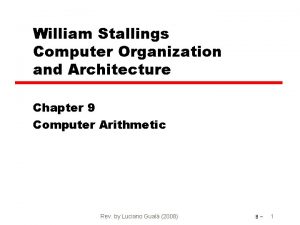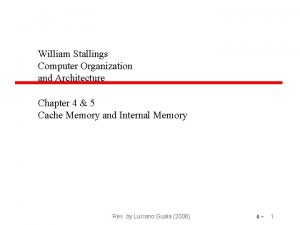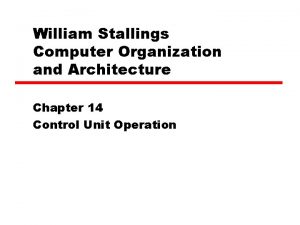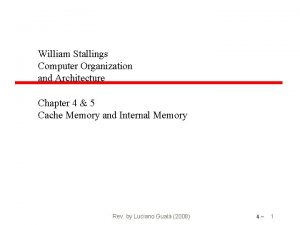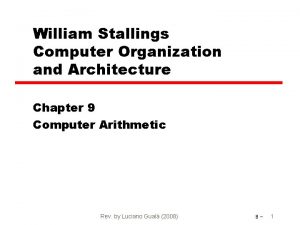William Stallings Computer Organization and Architecture Chapter 4




























































- Slides: 60

William Stallings Computer Organization and Architecture Chapter 4 Internal Memory

Characteristics z Location y CPU, Internal, External z Capacity y Word size, number of words z Unit of transfer y Word on bus, block, cluster z Access method y Direct, Random, Associative, Sequential z Performance y Access, Cycle, Transfer time z Physical type y Semiconductor, magnetic, optical z Physical characteristics y Volatile , Erasable z Organization y Physical arrangement of bits into words

Access Methods (1) z Sequential y. Start at the beginning and read through in order y. Access time depends on location of data and previous location ye. g. tape z Direct y. Individual blocks have unique address y. Access is by jumping to vicinity plus sequential search y. Access time depends on location and previous location ye. g. disk

Access Methods (2) z Random y. Individual addresses identify locations exactly y. Access time is independent of location or previous access ye. g. RAM z Associative y. Data is located by a comparison with contents of a portion of the store y. Access time is independent of location or previous access ye. g. cache

Memory Hierarchy z Registers y. In CPU z Internal or Main memory y. May include one or more levels of cache y“RAM” z External memory y. Backing store

Performance z Access time y. Time between presenting the address and getting the valid data z Memory Cycle time y. Time may be required for the memory to “recover” before next access y. Cycle time is access + recovery z Transfer Rate y. Rate at which data can be moved

Physical Characteristics z Decay z Volatility z Erasable z Power consumption

The Bottom Line z How much? y Capacity z How fast? y Time is money z How expensive? z Tradeoffs among all of these y E. g. Faster = More expensive, More = Less cost (per bit) but slower y Solution : Memory Hierarchy

Hierarchy List z Registers z L 1 Cache z L 2 Cache z Main memory z Disk cache z Disk z Optical z Tape z As one goes down the hierarchy y Decreasing cost per bit y Increasing capacity y Increasing access time y Decreasing frequency of access of the memory by the processor – locality of reference

So you want fast? z It is possible to build a computer which uses only static RAM (see later) z This would be very fast z This would need no cache y. How can you cache? z This would cost a very large amount

Locality of Reference z Temporal Locality y Programs tend to reference the same memory locations at a future point in time y Due to loops and iteration, programs spending a lot of time in one section of code z Spatial Locality y Programs tend to reference memory locations that are near other recently-referenced memory locations y Due to the way contiguous memory is referenced, e. g. an array or the instructions that make up a program z Locality of reference does not always hold, but it usually holds

Cache Example z Consider a Level 1 cache capable of holding 1000 words with a 0. 1 s access time. Level 2 is memory with a 1 s access time. z If 95% of memory access is in the cache: y T=(0. 95)*(0. 1 s) + (0. 05)*(0. 1+1 s) = 0. 15 s z If 5% of memory access is in the cache: y T=(0. 05)*(0. 1 s) + (0. 95)*(0. 1+1 s) = 1. 05 s z Want as many cache hits as possible! 1. 1 s 0% 100%

Semiconductor Memory z RAM y. Misnamed as all semiconductor memory is random access y. Read/Write y. Volatile y. Temporary storage y. Two main types: Static or Dynamic

Dynamic RAM z Bits stored as charge in capacitors z Charges leak z Need refreshing even when powered z Simpler construction z Smaller per bit z Less expensive z Need refresh circuits (every few milliseconds) z Slower z Main memory

Static RAM z Bits stored as on/off switches via flip-flops z No charges to leak z No refreshing needed when powered z More complex construction z Larger per bit z More expensive z Does not need refresh circuits z Faster z Cache

Read Only Memory (ROM) z Permanent storage z Microprogramming z Library subroutines z Systems programs (BIOS) z Function tables

Types of ROM z Written during manufacture y. Very expensive for small runs z Programmable (once) y. PROM y. Needs special equipment to program z Read “mostly” y. Erasable Programmable (EPROM) x. Erased by UV y. Electrically Erasable (EEPROM) x. Takes much longer to write than read y. Flash memory x. Erase whole memory electrically

Chip Organization z Consider an individual memory cell. Select line indicates if active, Control line indicates read or write. Control Select Cell Data In / Data Out (sense) Memory Cell Operations

Organization in detail z Some possible ways to create a 16 Mbit chip y 1 M of 16 bit words y 16 1 Mbit chips, one chip for each bit of the desired 16 bit word y A 2048 x 4 bit array. Consider a 4 bit word size, so 4, 194, 304 addressable locations x. Reduces number of address pins x. Multiplex row address and column address x. This example: 11 pins to address (211=2048), multiplex over the pins twice to get 22 bits (222 = 4 M) for each 4 bit word x. To access memory, first send an address for the row (RAS), then send the address for the column (CAS). Together this activates the SELECT line. Need four lines for the Data In/Sense lines. x. Adding one more pin doubles range of values so 4 times the capacity as we increase the dimensions

Typical 16 Mb DRAM (4 M x 4) A 0 A 1 … A 21

Refreshing z Refresh circuit included on chip z Disable chip z Count through rows z Read & Write back z Takes time z Slows down apparent performance

Packaging CE = Chip Enable, Vss = Ground, Vcc=+V, OE = Output Enable, WE = Write Enable

Module Organization y. Alternate Organization Using Modules to reference 256 K 8 bit words y 8 256 K chip for each bit of the desired 8 bit word y. Full 18 bit address presented to each module, a single bit output. Data distributed across all chips for a single word

Module Organization – Larger Memories z Can piece together existing modules to make even larger memories z Consider previous 256 K x 8 bit system y. If we want 1 M of memory, can tie together four of the 256 K x 8 bit modules y. How to tell which of the four modules contains the data we want? y. Need 20 address lines to reference 1 M x. Use lower 18 bits to reference address as before x. Use higher 2 bits into the Chip Select to enable only one of the four memory modules

Module Organization (2)

Error Correction z Hard Failure y. Permanent defect z Soft Error y. Random, non-destructive y. No permanent damage to memory z Hamming error correcting code one technique for detecting errors y. Similar to parity bit, but contains enough information to correct data with single bit errors

Cache z Small amount of fast memory z Sits between normal main memory and CPU z May be located on CPU chip or module

Cache operation - overview z CPU requests contents of memory location z Check cache for this data z If present, get from cache (fast) z If not present, read required block from main memory to cache z Then deliver from cache to CPU z Cache includes tags to identify which block of main memory is in each cache slot

Cache Design z If memory contains 2 n addressable words y Memory can be broken up into blocks with K words per block. Number of blocks = 2 n / K y Cache consists of C lines or slots, each consisting of K words y C << M y How to map blocks of memory to lines in the cache? Memory Cache Line 0 Line 1 … Line C-1 Block 0 Block 1 … Block (2 n/K)-1

Cache Design z Size z Mapping Function z Replacement Algorithm z Write Policy z Block Size z Number of Caches

Size does matter z Cost y. More cache is expensive z Speed y. More cache is faster (up to a point) y. Checking cache for data takes time x. Adding more cache would slow down the process of looking for something in the cache

Typical Cache Organization

Mapping Function z We’ll use the following configuration example y. Cache of 64 KByte y. Cache line / Block size is 4 bytes xi. e. cache is 16, 385 (214) lines of 4 bytes y. Main memory of 16 MBytes x 24 bit address x(224=16 M) x 16 Mbytes / 4 bytes-per-block 4 MB of Memory Blocks y. Somehow we have to map the 4 Mb of blocks in memory onto the 16 K of lines in the cache. Multiple blocks will have to map to the same line in the cache!

Direct Mapping z Simplest mapping technique - each block of main memory maps to only one cache line yi. e. if a block is in cache, it must be in one specific place z Formula to map a memory block to a cache line: yi = j mod c xi=Cache Line Number xj=Main Memory Block Number xc=Number of Lines in Cache

Direct Mapping with C=4 z Shrinking our example to a cache line size of 4 slots (each slot/line/block still contains 4 words): y Cache Line x 0 x 1 x 2 x 3 Memory Block Held 0, 1, 2, 3, 4, 5, 6, 7, 8, … 9, … 10, … 11, … 0, 1, 2, 3, C, 2 C, 3 C, … C+1, 2 C+1, 3 C+1, … C+2, 2 C+2, 3 C+2, … C+3, 2 C+3, 3 C+3, … y In general: x 0 x 1 x 2 x 3

Direct Mapping with C=4 Valid Dirty Block 0 Tag Slot 0 Block 1 Slot 1 Block 2 Slot 2 Block 3 Slot 3 Block 4 Cache Memory Don’t forget – each slot contains K words (e. g. 4 words) Block 5 Block 6 Block 7 Main Memory

Direct Mapping Address Structure z Address is in two parts y. Least Significant w bits identify unique word within a cache line y. Most Significant s bits specify one memory block y. The MSBs are split into a cache line field r and a tag of s-r (most significant)

Direct Mapping Address Structure V D Tag s-r Line or Slot r 1 1 8 14 Word w 2 z Given a 24 bit address (to access 16 Mb) z 2 bit word identifier (4 byte block) z 22 bit block identifier y 8 bit tag (=22 -14) y 14 bit slot or line z No two blocks in the same line have the same Tag field z Check contents of cache by finding line and checking Tag z Also need a Valid bit and a Dirty bit y Valid – Indicates if the slot holds a block belonging to the program being executed y Dirty – Indicates if a block has been modified while in the cache. Will need to be written back to memory before slot is reused for another block

Direct Mapping Example, 64 K Cache Main Memory Cache Memory Addr Tag W 0 W 1 W 2 W 3 00 1 B F 1 F 2 F 3 F 4 11 12 13 14 0 1 2 3 4 5. . Addr (hex) Line 0 Line 1 0000001 000002 000003 000004 … 1 B 0004 1 B 0005 1 B 0006 1 B 0007 Data F 1 F 2 F 3 F 4 AB 11 12 13 14 214 -1 1 B 0007 = 0001 1011 0000 0111 Word = 11, Line = 0000 01, Tag= 0001 1011

Direct Mapping Example Original Example, 64 K Cache with 4 words per Block

Direct Mapping pros & cons z Simple z Inexpensive z Fixed location for given block y. If a program accesses 2 blocks that map to the same line repeatedly, cache misses are very high – condition called thrashing

Fully Associative Mapping z A fully associative mapping scheme can overcome the problems of the direct mapping scheme y A main memory block can load into any line of cache y Memory address is interpreted as tag and word y Tag uniquely identifies block of memory y Every line’s tag is examined for a match y Also need a Dirty and Valid bit (not shown in examples) z But Cache searching gets expensive! y Ideally need circuitry that can simultaneously examine all tags for a match y Lots of circuitry needed, high cost z Need replacement policies now that anything can get thrown out of the cache (will look at last)

Fully Associative Cache Organization

Associative Mapping Address Structure Tag 22 bit Word 2 bit z 22 bit tag stored with each 32 bit block of data z Compare tag field with tag entry in cache to check for hit z Least significant 2 bits of address identify which 8 bit word is required from 32 bit data block z e. g. y Address: FFFFFC = 1111 1111 1100 x. Tag: Left 22 bits, truncate on left: • 11 1111 1111 • 3 FFFFF y Address: 16339 C = 0001 0110 0011 1001 1100 x. Tag: Left 22 bits, truncate on left: • 00 0101 1000 1110 0111 • 058 CE 7

Associative Mapping Example F F F

Set Associative Mapping z Compromise between fully-associative and directmapped cache y Cache is divided into a number of sets y Each set contains a number of lines y A given block maps to any line in a specific set x. Use direct-mapping to determine which set in the cache corresponds to a set in memory x. Memory block could then be in any line of that set y e. g. 2 lines per set x 2 way associative mapping x. A given block can be in one of 2 lines in a specific set y e. g. K lines per set x. K way associative mapping x. A given block can be in one of K lines in a specific set x. Much easier to simultaneously search one set than all lines

Set Associative Mapping z To compute cache set number: y. Set. Num = j mod v xj = main memory block number xv = number of sets in cache Main Memory Block 0 Block 1 Set 0 Set 1 Slot 0 Block 2 Slot 1 Block 3 Slot 2 Block 4 Slot 3 Block 5

Two Way Set Associative Cache Organization

Set Associative Mapping Address Structure Tag 9 bit Set 13 bit Word 2 bit z E. g. given a 13 bit set number for 24 bit address z Use set field to determine cache set to look in z Compare tag field of all slots in the set to see if we have a hit, e. g. : y Address = 16339 C = 0001 0110 0011 1001 1100 x. Tag = 0 0010 1100 = 02 C x. Set = 0 1100 1110 0111 = 0 CE 7 x. Word = 00 = 0 y Address = 008004 = 0000 1000 0000 0100 x. Tag = 0 0001 = 001 x. Set = 0 0000 0001 = 0001 x. Word = 00 = 0

Two Way Set Associative Mapping Example Error in book: 001 tag in cache should be 02 C (or come from a different memory block!) Address 008004 Address 16339 C 11235813

K-Way Set Associative z Two-way set associative gives much better performance than direct mapping y. Just one extra slot avoids the thrashing problem z Four-way set associative gives only slightly better performance over two-way z Further increases in the size of the set has little effect other than increased cost of the hardware!

Replacement Algorithms (1) Direct mapping z No choice z Each block only maps to one line z Replace that line

Replacement Algorithms (2) Associative & Set Associative z Algorithm must be implemented in hardware (speed) z Least Recently used (LRU) y e. g. in 2 way set associative, which of the 2 block is LRU? x. For each slot, have an extra bit, USE. Set to 1 when accessed, set all others to 0. y For more than 2 -way set associative, need a time stamp for each slot - expensive z First in first out (FIFO) y Replace block that has been in cache longest y Easy to implement as a circular buffer z Least frequently used y Replace block which has had fewest hits y Need a counter to sum number of hits z Random y Almost as good as LFU and simple to implement

Write Policy z Must not overwrite a cache block unless main memory is up to date. I. e. if the “dirty” bit is set, then we need to save that cache slot to memory before overwriting it z This can cause a BIG problem y. Multiple CPUs may have individual caches x. What if a CPU tries to read data from memory? It might be invalid if another processor changed its cache for that location! x. Called the cache coherency problem y. I/O may address main memory directly too

Write through z Simplest technique to handle the cache coherency problem - All writes go to main memory as well as cache. z Multiple CPUs must monitor main memory traffic (snooping) to keep local cache local to its CPU up to date in case another CPU also has a copy of a shared memory location in its cache z Simple but Lots of traffic z Slows down writes z Other solutions: noncachable memory, hardware to maintain coherency

Write Back z Updates initially made in cache only z Dirty bit for cache slot is cleared when update occurs z If block is to be replaced, write to main memory only if dirty bit is set z Other caches can get out of sync z If I/O must access invalidated main memory, one solution is for I/O to go through cache y Complex circuitry z Only ~15% of memory references are writes

Cache Performance z Two measures that characterize the performance of a cache are the hit ratio and the effective access time y Hit Ratio = (Num times referenced words are in cache) --------------------------(Total number of memory accesses) Eff. Access Time = (# hits)(Time. Per. Hit)+(# misses) (Time. Per. Miss) ----------------------------(Total number of memory accesses)

Cache Performance Example Block 0 Memory 0 -15 Slot 0 Block 1 16 -31 Slot 1 Block 2 32 -47 Slot 2 Block 3 48 -63 Slot 3 Block 4 64 -79 Block 5 80 -95 Block 6 … z Direct-Mapped Cache Memory Cache access time = 80 ns Main Memory time = 2500 ns Block 7

Cache Performance Example z Sample program executes from memory location 48 -95 once. Then it executes from 15 -31 in a loop ten times before exiting.

Cache Performance Example z Hit Ratio: 213 / 218 = 97. 7% z Effective Access Time: ((213)*(80 ns)+(5)(2500 ns)) / 218 = 136 ns z Although the hit ratio is high, the effective access time in this example is 75% longer than the cache access time due to the large amount of time spent during a cache miss z What sequence of main memory block accesses would result in much worse performance?
 William stallings computer organization and architecture
William stallings computer organization and architecture Simplified data communication model
Simplified data communication model William stallings computer networks
William stallings computer networks William stallings computer networks
William stallings computer networks William stallings network security essentials 5th edition
William stallings network security essentials 5th edition Network security essentials william stallings ppt
Network security essentials william stallings ppt William stallings
William stallings William stallings
William stallings Stallings william comunicaciones y redes de computadores
Stallings william comunicaciones y redes de computadores Cryptography william stallings
Cryptography william stallings Difference between computer architecture and organization
Difference between computer architecture and organization Computer organization and architecture 10th solution
Computer organization and architecture 10th solution Software engineering virtual lab iit kharagpur
Software engineering virtual lab iit kharagpur Introduction to computer organization and architecture
Introduction to computer organization and architecture Spec rating formula in computer organization
Spec rating formula in computer organization Computer organization and architecture 10th edition
Computer organization and architecture 10th edition Computer organization and architecture definition
Computer organization and architecture definition 1s complement
1s complement Computer architecture and organization
Computer architecture and organization Process organization in computer organization
Process organization in computer organization Bus architecture in computer organization
Bus architecture in computer organization Instruction set architecture in computer organization
Instruction set architecture in computer organization Memory organization in computer architecture
Memory organization in computer architecture Basic structure of a computer system
Basic structure of a computer system Complete computer description in computer organization
Complete computer description in computer organization Design of a basic computer
Design of a basic computer Fixed partitions
Fixed partitions Stallings garbage pickup
Stallings garbage pickup Apollo and daphne translation
Apollo and daphne translation Metodo stallings
Metodo stallings Least cost routing algorithm
Least cost routing algorithm Block organization
Block organization Arm architecture and organization
Arm architecture and organization Interrupt cycle flow chart
Interrupt cycle flow chart Basic computer organization and design
Basic computer organization and design Neumann dst
Neumann dst System bus in computer
System bus in computer Return architecture
Return architecture Components of information architecture
Components of information architecture Bapo business architecture process organization
Bapo business architecture process organization Timing and control in computer architecture
Timing and control in computer architecture Evolution of computer architecture
Evolution of computer architecture Harris & harris digital design and computer architecture
Harris & harris digital design and computer architecture Linear pipeline in computer architecture
Linear pipeline in computer architecture Digital design and computer architecture
Digital design and computer architecture Mux computer architecture
Mux computer architecture Digital design and computer architecture
Digital design and computer architecture Digital design and computer architecture
Digital design and computer architecture Assembly language and computer architecture
Assembly language and computer architecture Hazard detection and resolution
Hazard detection and resolution Pipelined mips datapath
Pipelined mips datapath Bubble pushing example
Bubble pushing example Digital logic and computer architecture
Digital logic and computer architecture The apollo guidance computer: architecture and operation
The apollo guidance computer: architecture and operation Digital design and computer architecture: arm edition
Digital design and computer architecture: arm edition Nano programming in coa
Nano programming in coa Accessing io devices in computer organization
Accessing io devices in computer organization Data representation in computer organization
Data representation in computer organization Organization of digital computer
Organization of digital computer Single bus structure in computer organization
Single bus structure in computer organization Computer organization course
Computer organization course


